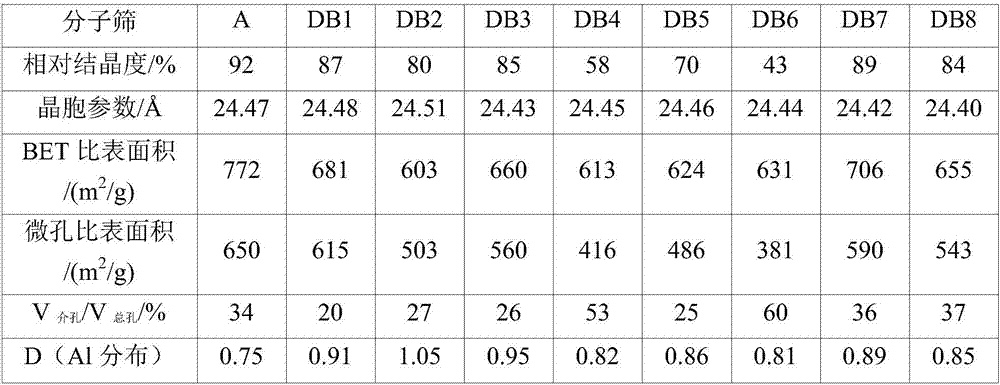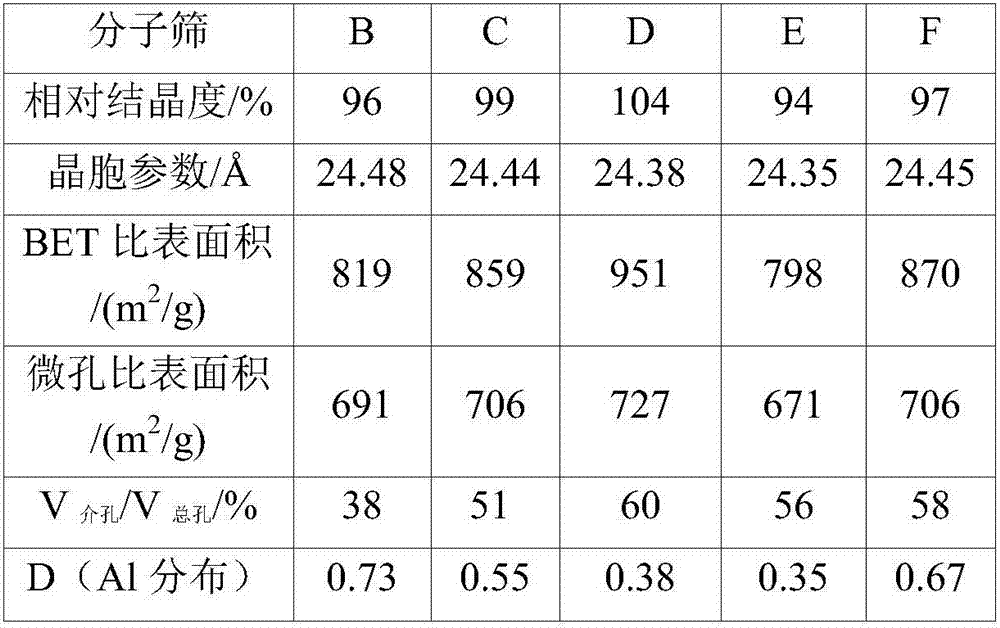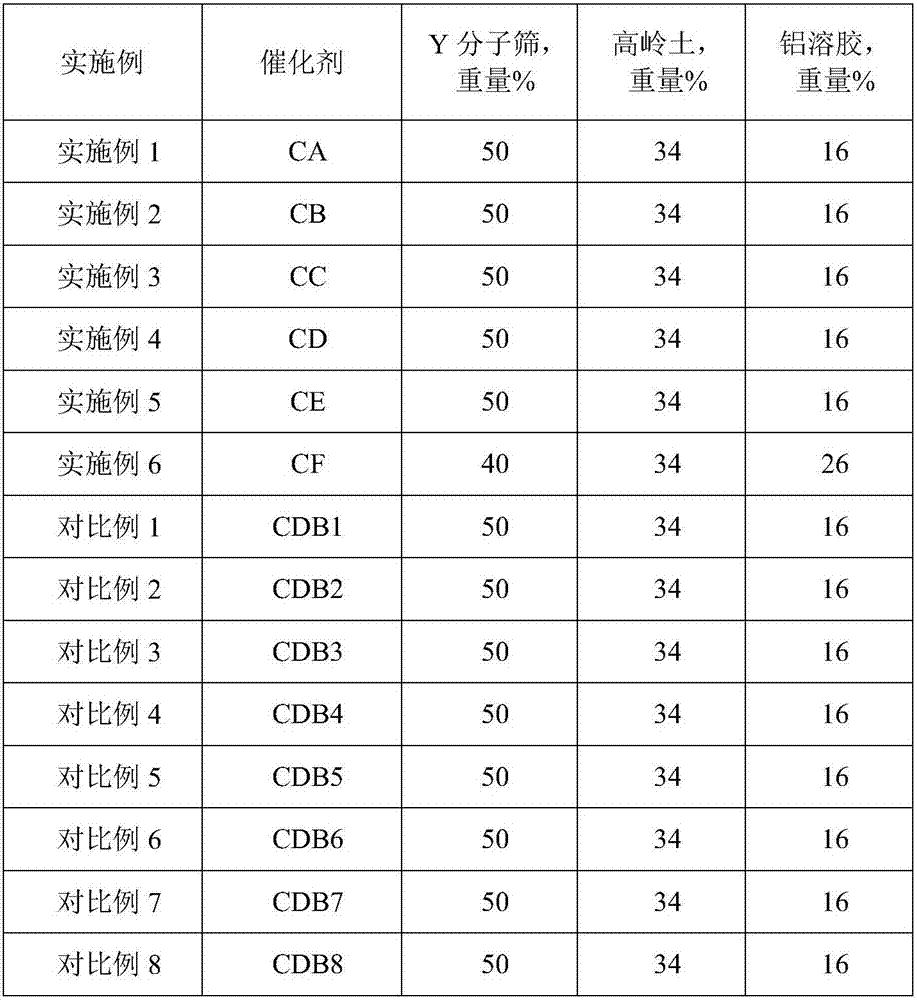Catalytic cracking catalyst and preparation method thereof
A catalytic cracking and catalyst technology, applied in physical/chemical process catalysts, molecular sieve catalysts, chemical instruments and methods, etc., can solve the problem of low micropore volume and achieve high gasoline yield and excellent heavy oil conversion ability
- Summary
- Abstract
- Description
- Claims
- Application Information
AI Technical Summary
Problems solved by technology
Method used
Image
Examples
preparation example Construction
[0032] The present invention also provides a method for preparing a catalytic cracking catalyst, the preparation method comprising: mixing the raw materials used to prepare the catalytic cracking catalyst with water, and then performing beating and spray drying; wherein, in terms of dry weight, the raw materials include 25 - 75% by weight of mesoporous-rich Y molecular sieve, 10-30% by weight of precursors of inorganic oxide binders and 15-65% by weight of natural minerals; crystals of said mesoporous-rich Y molecular sieve The cell parameter is 24.35-24.55 angstroms, the relative crystallinity is ≥92%, and the Al distribution parameter D of the molecular sieve satisfies: 0.3≤D≤0.8, wherein, D=Al(S) / Al(C), Al(S) represents The aluminum content of any region larger than 100 square nanometers within the distance H from the edge of the molecular sieve crystal grain measured by the TEM-EDS method, Al(C) represents the geometry of the crystal plane of the molecular sieve crystal gra...
preparation Embodiment 1
[0052] With Y molecular sieve (catalyst Qilu branch production, unit cell parameter ) and NH 4 Cl and distilled water were mixed and beaten evenly at a ratio of 1:1:10, ammonium was exchanged at 70°C for 1 hour, the sample was filtered, washed, and dried, and the sodium content of the molecular sieve was below 5% by weight. The above-mentioned molecular sieves were calcined at 600° C. and 100% steam for 2 hours. Get roasted molecular sieve 100g (dry basis mass) and NH 4 Cl and distilled water were mixed and beaten evenly at a ratio of 1:1:10, ammonium was exchanged at 70°C for 1 hour, the sample was filtered, washed, and dried, and the sodium content of the molecular sieve was below 3% by weight. The above-mentioned molecular sieves were calcined at 620° C. and 100% steam for 2.5 hours. After roasting, add water and beat the sample to obtain a molecular sieve slurry with a solid content of 10% by weight, add 11.23g NaOH (purity 96%), heat up to 50°C and stir at a constant ...
preparation Embodiment 2
[0070] With Y molecular sieve (catalyst Qilu branch production, unit cell parameter ) and NH 4 Cl and distilled water were mixed and beaten evenly at a ratio of 1:1:10, ammonium was exchanged at 70°C for 1 hour, the sample was filtered, washed, and dried, and the sodium content of the molecular sieve was below 5% by weight. The above-mentioned molecular sieves were calcined at 600° C. and 100% steam for 2 hours. Get roasted molecular sieve 100g (dry basis mass) and NH 4 Cl and distilled water were mixed and beaten evenly at a ratio of 1:1:10, ammonium was exchanged at 70°C for 1 hour, the sample was filtered, washed, and dried, and the sodium content of the molecular sieve was below 3% by weight. The above-mentioned molecular sieves were calcined at 650° C. and 100% steam for 1 hour. Add water and beat the roasted sample to obtain a molecular sieve slurry with a solid content of 10% by weight, add 35g NaOH (purity 96%), heat up to 50°C and stir at a constant temperature fo...
PUM
 Login to View More
Login to View More Abstract
Description
Claims
Application Information
 Login to View More
Login to View More - R&D
- Intellectual Property
- Life Sciences
- Materials
- Tech Scout
- Unparalleled Data Quality
- Higher Quality Content
- 60% Fewer Hallucinations
Browse by: Latest US Patents, China's latest patents, Technical Efficacy Thesaurus, Application Domain, Technology Topic, Popular Technical Reports.
© 2025 PatSnap. All rights reserved.Legal|Privacy policy|Modern Slavery Act Transparency Statement|Sitemap|About US| Contact US: help@patsnap.com



